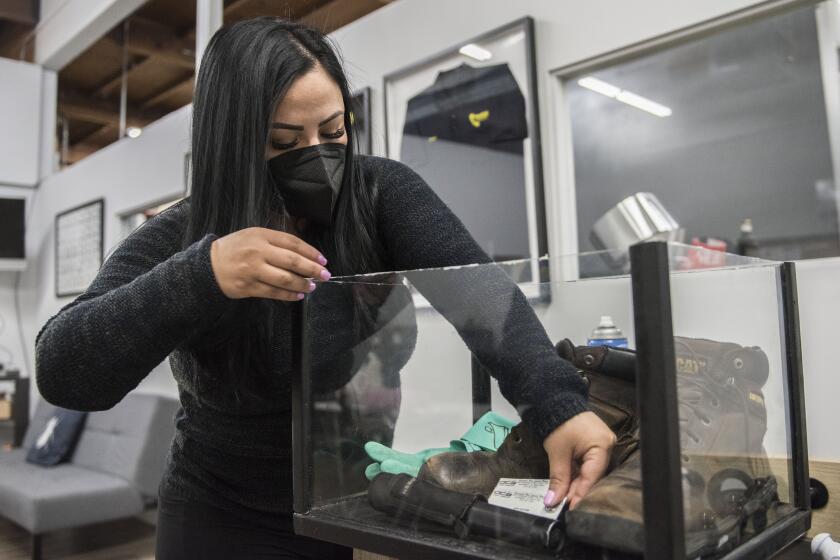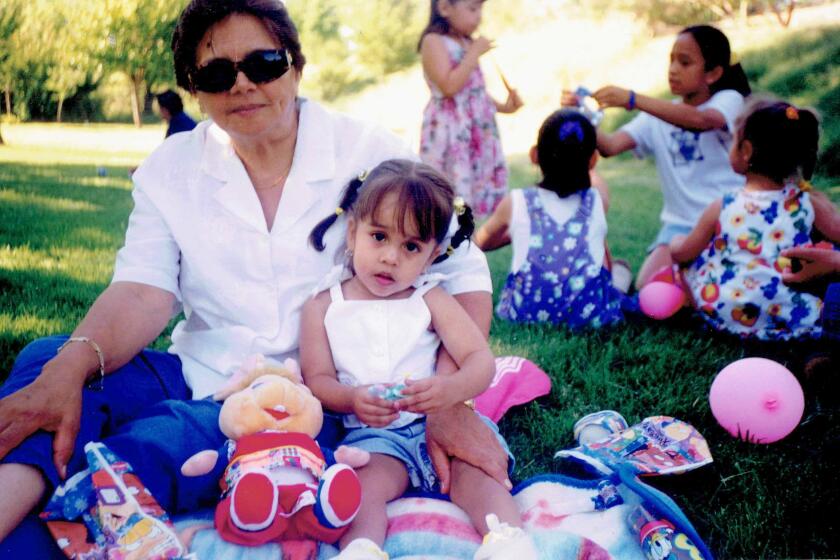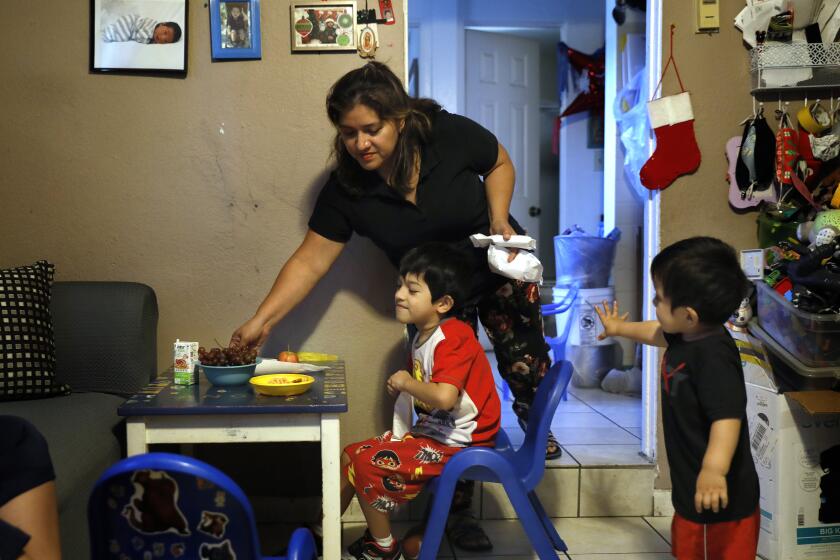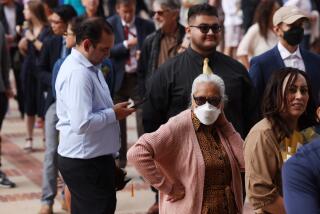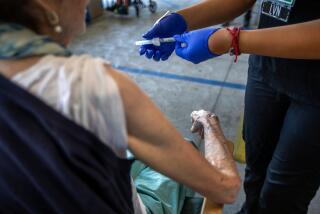L.A. County may be at the start of a winter COVID-19 surge, health official says
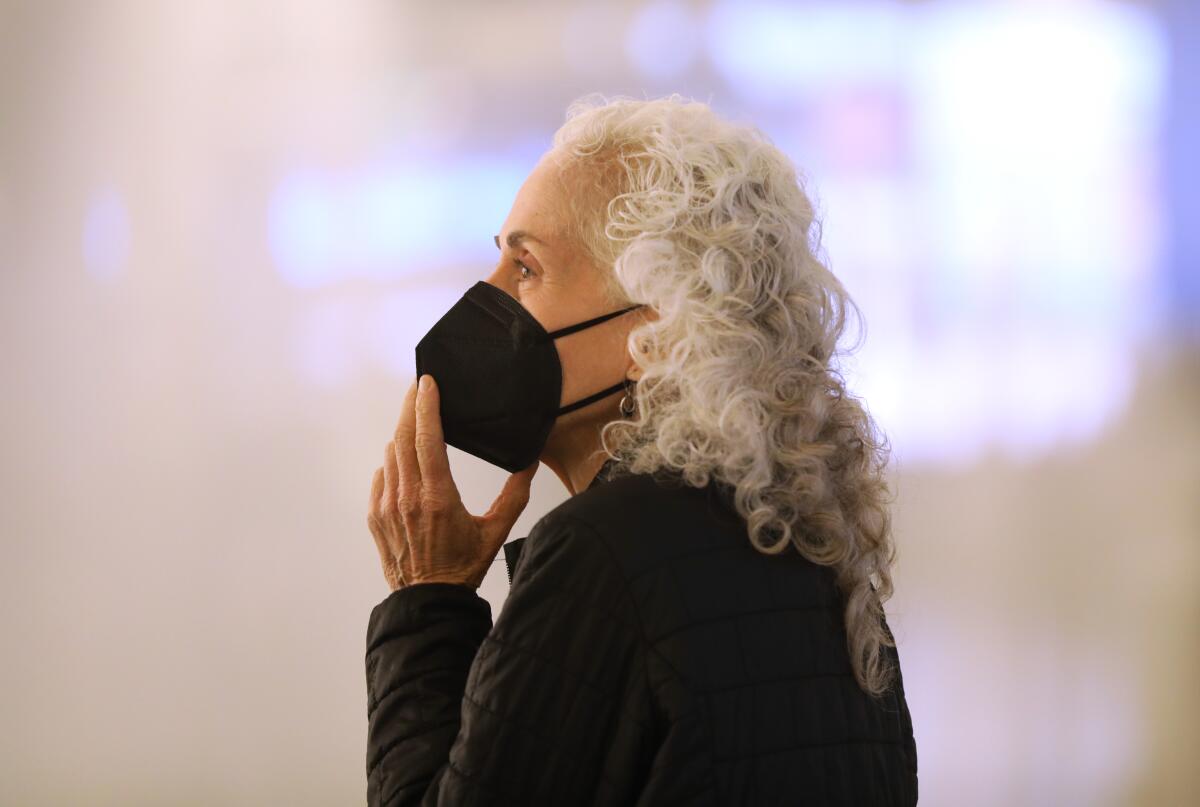
- Share via
Los Angeles County is possibly at the start of a winter COVID-19 surge, its public health director said Thursday.
Weekly coronavirus case rates have climbed by 33% over the last two weeks, sending the nation’s most populous county back into the worst coronavirus transmission tier, colored red on maps published by the U.S. Centers for Disease Control and Prevention.
Also rising in L.A. County are COVID-19 hospitalizations, which just before Thanksgiving hit a new low since the Delta surge began in the summer. COVID-19 hospitalizations are up 21% since Nov. 22, rising from 551 to 667 as of Wednesday.
“We do expect increases to continue on the heels of our Thanksgiving gatherings, but already based on the trends, we are looking at the possible beginnings of a winter surge,” L.A. County Public Health Director Barbara Ferrer said.
Another point of concern was a slight increase in coronavirus cases among schoolchildren. In the week after Thanksgiving, coronavirus cases among schoolchildren rose to their highest level since late September, Ferrer said.
“If, as we suspect, this increase in cases reflects transmission that took place during holiday gatherings, we should consider this an early warning about the upcoming December holiday,” Ferrer said. “That makes now a particularly critical time to vaccinate school-aged children.”
On Thursday, federal officials cleared the way for the Pfizer-BioNTech vaccine to be available to boost fully vaccinated 16- and 17-year-olds.
It is not believed that classrooms are a major source of coronavirus transmission because of measures such as masking in indoor classrooms. For the week of Dec. 4, L.A. County schools had only three outbreaks in K-12 settings. An outbreak is defined as a situation in which three or more coronavirus cases occur in a school setting and are believed to be related to one another.
This winter’s potential surge is not expected to be as severe as the historic tide of severe illness that overwhelmed L.A. County’s hospitals last year, Ferrer said, given how many people are vaccinated. Among residents of all ages, 67% are fully vaccinated, and 75% have had at least one dose, according to The Times’ vaccination tracker.
In California, younger Latinos are dying of COVID-19 at much higher rates than their white and Asian counterparts.
Those levels are not as high as vaccination rates in the San Francisco Bay Area, which remain the highest in the state, but they are having an effect.
L.A. County has already observed a lower percentage of infected people needing hospitalization; during the summer Delta surge, 5% to 6% of coronavirus cases needed hospitalization, whereas last year, 15% to 20% of cases needed hospital care, Ferrer said.
“That is very good news and really reflects the power of those vaccines,” Ferrer said.
Still, any increase in coronavirus cases makes it more likely that people will need hospitalization and that more people will die, Ferrer said.
Rosa Cardenas built a successful garment business with a first-grade education. The family’s progress is now threatened by the pandemic.
Booster shots are increasingly being seen as key to best protecting against COVID-19. For the seven-day period that ended Nov. 29, for every 100,000 residents who got a booster, only seven were infected with the virus, compared with 43 who were vaccinated but hadn’t received their booster.
“This means that the booster offered six times the protection of the primary vaccine series alone,” Ferrer said. “Please don’t wait any longer. The boosters are essential.”
Unvaccinated people were far more likely to get infected than vaccinated people. For every 100,000 unvaccinated residents, 165 people were infected that week.
Success seemed within reach for two immigrants — until the COVID-19 pandemic. Now, a $10 bill in Glenda Valenzuela’s purse can feel like a godsend.
One point of concern is that a surge in cases could disproportionately affect Black and Latino residents of L.A. County, who have been more likely in previous coronavirus surges to be infected, hospitalized and die than white and Asian American residents. Many workers who must physically go to work and are disproportionately exposed to the coronavirus, are Black or Latino, Ferrer said.
“This disproportionality in health outcomes associated with our surges are a stark reminder that the conditions in which people work and live can place them at much higher risk during a pandemic,” Ferrer said. “Our strategies for closing gaps need to include protecting workers and supporting families that have fewer resources.”
L.A. County has struggled to reduce racial and ethnic disparities in vaccinations. Among those 5 and older, 55% of Black residents and 60% of Latino residents have received at least one dose of vaccine, compared with 73% of white, 77% of Native American and 82% of Asian American residents, according to data posted on the county’s website.
Some counties in the San Francisco Bay Area have smaller disparities in vaccinations by race and ethnicity.
In San Francisco, 74% of white, 76% of Black and 86% of Asian American residents of all ages have received at least one dose of vaccine; vaccination rates are more than 90% for Latino and Native American residents.
In Northern California’s most populous county, Santa Clara, 69% of Black, 73% of Latino, 74% of white, 88% of Native American and 92% of Asian American residents have received at least one shot.
“We don’t really see the extent of disparities that are seen in many other communities when it comes to Hispanic/Latino and African American populations,” Dr. Ahmad Kamal, a top official with Santa Clara County’s COVID-19 response team, recently said at a public meeting. “And this is really a testament to some of the great outreach being done in these communities in trying to get vaccinations to everybody.”
And in the region’s second-most populous county, Alameda, 67% of Black, 68% of Latino, 76% of white, 87% of Asian American and 98% of Native American residents have received at least one dose.
Ferrer said L.A. County aims to make vaccines widely available through mobile clinics and home visits. “But there is this issue of making sure people can build their confidence in the vaccines,” she said. “And I think we certainly are struggling in making sure that people do feel confident that vaccines are safe.”
Another point of concern is that children ages 5 to 11 are more likely to get vaccinated if they live in wealthier neighborhoods. In the lowest-income areas of L.A. County, only 11% of children in this age group have been vaccinated, compared with 28% of children in the age group in wealthier neighborhoods. The countywide rate for this age group is 16%.
Sixty percent of L.A. County’s children ages 5 to 11 live in low-income areas.
The effect of the coronavirus’ Omicron variant remains a big question. Omicron was first reported by scientists in South Africa to the World Health Organization just before Thanksgiving, and the strain has since been detected worldwide.
Virtually all of the coronavirus cases now being analyzed in L.A. County have been of the Delta variant, which has been the dominant variant nationwide for many months. So far, there have been seven Omicron cases identified in L.A. County, including two new ones reported Friday.
Omicron is believed to be highly transmissible.
Though early reports of people hospitalized with coronavirus infections in South Africa have noted that most are not severely ill, “it’s much too early to generalize from these data,” Ferrer said. “We will understand a lot more about the kinds of infections Omicron can cause when we see how it affects older people, people with underlying health conditions and unvaccinated populations.”
Britain’s health secretary, Sajid Javid, called Omicron “an even more formidable foe” than Delta as the government there rolled out new COVID-19 restrictions.
In England, that meant new orders announced this week, such as requiring mask wearing in most indoor public settings and proof of vaccination or a recent negative coronavirus test for adults to enter certain venues and events. Similar rules have been in place in some parts of California for some time.
Britain is also challenged because it was much slower than the U.S. in starting to vaccinate children, experts have said.
More to Read
Sign up for Essential California
The most important California stories and recommendations in your inbox every morning.
You may occasionally receive promotional content from the Los Angeles Times.
